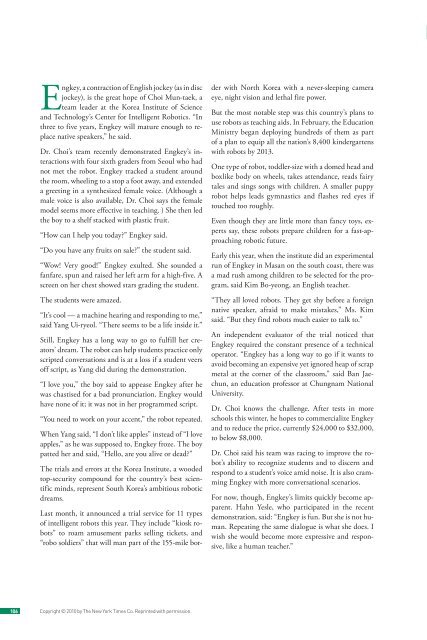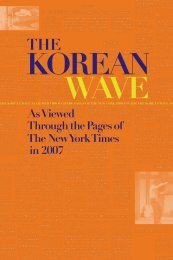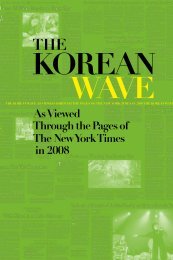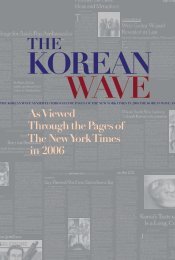The Korean Wave 2010-2011 - Korean Cultural Service
The Korean Wave 2010-2011 - Korean Cultural Service
The Korean Wave 2010-2011 - Korean Cultural Service
You also want an ePaper? Increase the reach of your titles
YUMPU automatically turns print PDFs into web optimized ePapers that Google loves.
THE NEW YORK TIMES, Thursday, September 2, <strong>2010</strong>A8Engkey, a contraction of English jockey (as in discjockey), is the great hope of Choi Mun-taek, ateam leader at the Korea Institute of Scienceand Technology’s Center for Intelligent Robotics. “Inthree to five years, Engkey will mature enough to replacenative speakers,” he said.Dr. Choi’s team recently demonstrated Engkey’s interactionswith four sixth graders from Seoul who hadnot met the robot. Engkey tracked a student aroundthe room, wheeling to a stop a foot away, and extendeda greeting in a synthesized female voice. (Although amale voice is also available, Dr. Choi says the femalemodel seems more effective in teaching. ) She then ledthe boy to a shelf stacked with plastic fruit.“How can I help you today?” Engkey said.“Do you have any fruits on sale?” the student said.“Wow! Very good!” Engkey exulted. She sounded afanfare, spun and raised her left arm for a high-five. Ascreen on her chest showed stars grading the student.der with North Korea with a never-sleeping cameraeye, night vision and lethal fire power.But the most notable step was this country’s plans touse robots as teaching aids. In February, the EducationMinistry began deploying hundreds of them as partof a plan to equip all the nation’s 8,400 kindergartenswith robots by 2013.One type of robot, toddler-size with a domed head andboxlike body on wheels, takes attendance, reads fairytales and sings songs with children. A smaller puppyrobot helps leads gymnastics and flashes red eyes iftouched too roughly.Even though they are little more than fancy toys, expertssay, these robots prepare children for a fast-approachingrobotic future.Early this year, when the institute did an experimentalrun of Engkey in Masan on the south coast, there wasa mad rush among children to be selected for the program,said Kim Bo-yeong, an English teacher.<strong>Korean</strong> Isle LooksAbroad Foran Education at HomeBy CHOE SANG-HUN<strong>The</strong> students were amazed.“It’s cool — a machine hearing and responding to me,”said Yang Ui-ryeol. “<strong>The</strong>re seems to be a life inside it.”Still, Engkey has a long way to go to fulfill her creators’dream. <strong>The</strong> robot can help students practice onlyscripted conversations and is at a loss if a student veersoff script, as Yang did during the demonstration.“I love you,” the boy said to appease Engkey after hewas chastised for a bad pronunciation. Engkey wouldhave none of it; it was not in her programmed script.“You need to work on your accent,” the robot repeated.When Yang said, “I don’t like apples” instead of “I loveapples,” as he was supposed to, Engkey froze. <strong>The</strong> boypatted her and said, “Hello, are you alive or dead?”<strong>The</strong> trials and errors at the Korea Institute, a woodedtop-security compound for the country’s best scientificminds, represent South Korea’s ambitious roboticdreams.Last month, it announced a trial service for 11 typesof intelligent robots this year. <strong>The</strong>y include “kiosk robots”to roam amusement parks selling tickets, and“robo soldiers” that will man part of the 155-mile bor-“<strong>The</strong>y all loved robots. <strong>The</strong>y get shy before a foreignnative speaker, afraid to make mistakes,” Ms. Kimsaid. “But they find robots much easier to talk to.”An independent evaluator of the trial noticed thatEngkey required the constant presence of a technicaloperator. “Engkey has a long way to go if it wants toavoid becoming an expensive yet ignored heap of scrapmetal at the corner of the classroom,” said Ban Jaechun,an education professor at Chungnam NationalUniversity.Dr. Choi knows the challenge. After tests in moreschools this winter, he hopes to commercialize Engkeyand to reduce the price, currently $24,000 to $32,000,to below $8,000.Dr. Choi said his team was racing to improve the robot’sability to recognize students and to discern andrespond to a student’s voice amid noise. It is also crammingEngkey with more conversational scenarios.For now, though, Engkey’s limits quickly become apparent.Hahn Yesle, who participated in the recentdemonstration, said: “Engkey is fun. But she is not human.Repeating the same dialogue is what she does. Iwish she would become more expressive and responsive,like a human teacher.”SEOGWIPO, South KoreaHere on Jeju Island, famous for its tangerinegroves, pearly beaches and honeymoonresorts, South Korea is conducting a boldeducational experiment, one intended to bolster opportunityat home and attract investment from abroad.By 2015, if all goes according to plan, 12 prestigiousWestern schools will have opened branch campuses in agovernment-financed, 940-acre Jeju Global EducationCity, a self-contained community within Seogwipo,where everyone — students, teachers, administrators,doctors, store clerks — will speak only English. <strong>The</strong>first school, North London Collegiate, broke groundfor its campus this month.While this is the country’s first enclave constructedexpressly around foreign-style education, individualcampuses are opening elsewhere. Dulwich College, aprivate British school, is scheduled to open a branch inSeoul, the capital, in a few weeks. And the ChadwickSchool of California is set to open a branch in Songdo, anew town rising west of Seoul, around the same time.What is happening in South Korea is part of the globalexpansion of Western schools — a complex trend fueledby parents in Asia and elsewhere who want to be able tokeep their families together while giving their childrena more global and English-language curriculum beginningwith elementary school, and by governments hopingfor economic rewards from making their countriesmore attractive to foreigners with money to invest.“We will do everything humanly possible to create anenvironment where your children must speak English,even if they are not abroad,” Jang Tae-young, a Jeju official,recently told a group of <strong>Korean</strong> parents.By inviting leading Western schools, the governmentis hoping to address one of the notorious stress pointsin South <strong>Korean</strong> society. Many parents want to sendchildren abroad so they can learn English and avoidthe crushing pressure and narrow focus of the <strong>Korean</strong>educational system. <strong>The</strong> number of South <strong>Korean</strong> studentsfrom elementary school through high school whogo abroad for education increased to 27,350 in 2008from 1,840 in 1999, according to government data.But this arrangement often resulted in the fracturing offamilies, with the mother accompanying the childrenabroad and the father becoming a “goose” — by stayingbehind to earn the money to finance these venturesand taking occasional transoceanic flights to visit.106 Copyright © <strong>2010</strong> by <strong>The</strong> New York Times Co. Reprinted with permission.107





